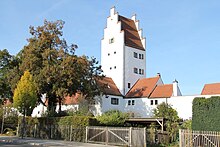Pocket Tower (Ingolstadt)
The pocket tower , or more rarely the pocket gate tower, is a side gate of the Ingolstadt city wall. It was built in 1390 as part of the urban expansion that took place in the second half of the 14th century . The name of the five-storey building probably goes back to the use of roof pockets for the gable roof that extends between the stepped gables .
In addition to the Münzbergtor , which lies directly on the Danube, the pocket tower further north was for a long time the only outlet on the southwest side of the second city wall, which is still largely preserved today. In addition, the pocket tower is the highest gate on the city wall. However, when the Ingolstadt fortress was expanded in the 16th century , it was not provided with a bulwark. In the classicist fortress , the still-preserved Fronte Preysing (Fronte 79) was placed in front of the pocket tower.
Over the centuries, the pocket tower was used as an executioner's apartment and as a city prison. During the witch hunts at the end of the 16th century there were numerous tortures in the pocket tower, which the later Bavarian elector Maximilian I also attended and who complained to his father, Wilhelm V, about the lax methods used during the interrogations in Ingolstadt.
The former bridge of the pocket tower, which spanned the moat that enclosed the entire city fortifications, no longer exists today.
literature
- Gerd A. Hits: Sightseeing flight over old Ingolstadt. Wartberg, Gudensberg-Gleichen 2000, p. 27, ISBN 3861349604
Web links
- Stadtmuseum Ingolstadt Use of the pocket tower during the witch hunt
Coordinates: 48 ° 45 ′ 42 ″ N , 11 ° 25 ′ 13 ″ E

